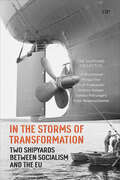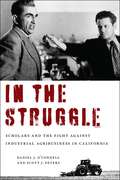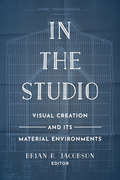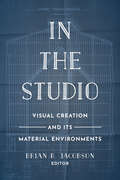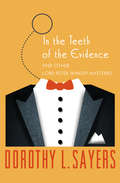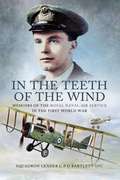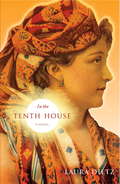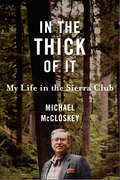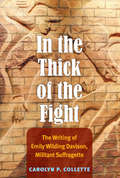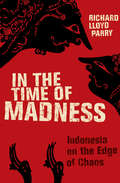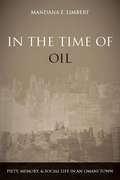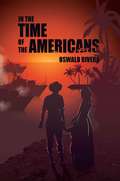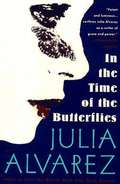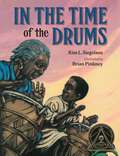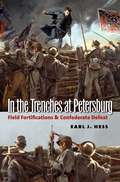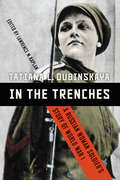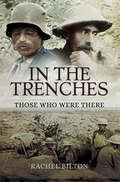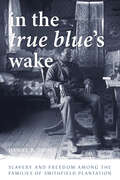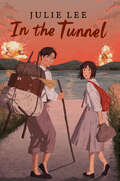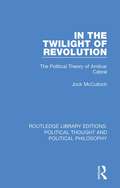- Table View
- List View
In the Spirit of the Maggid
by Paysach J. KrohnFor more than two decades, Rabbi Paysach Krohn has been inspiring and enthralling tens of thousands of readers with his "Maggid" series. Now the "American Maggid" is finally back again with a long-awaited new collection of unforgettable stories. There are many reasons why Rabbi Krohn's "Maggid" books make up one of the bestselling series in Jewish literary history. One reason is - the stories themselves. Each story is true, and each one is different. Each one is short enough to pack a punch, but long enough to touch the heart and ignite the soul. Some stories go back decades, even centuries, while others are pure twenty-first century - but all of them speak to our lives, to our contemporary concerns and challenges. Another reason is - the author himself. The warmth, perception, and insight of the man known as the American Maggid comes through in every line, every story. Rabbi Krohn understands us, our strengths and weaknesses, and he loves us as well. In his stories we can feel this acceptance and affection and therefore we allow the stories to teach us -- and to touch us. The maggidim of past centuries had their own special tools to reach the people: fascinating stories, humor - and, most of all, concern and caring for their people. These tools are what make up the "spirit of the maggidim." And this is what readers will enjoy in this new, wonderfully insightful book, In the Spirit of the Maggid.
In the Storms of Transformation: Two Shipyards between Socialism and the EU (German and European Studies #56)
by Andrew Hodges Philipp Ther Ulf Brunnbauer Piotr Filipkowski Stefano Petrungaro Peter WegenschimmelIn the 1990s, states in what would become the eastern edge of the European Union transformed their political systems and economies, leaving state socialism behind for liberal democracies and free markets. In the ensuing decades, two shipyards that were once the pride of their cities – in Gdynia, Poland, and Pula, Croatia – went bankrupt, unable to withstand global competition. Through an interdisciplinary study of these two shipyards, In the Storms of Transformation brings together a team of researchers to re-evaluate the shift from state socialism to market capitalism and offer a new periodization. With perspectives from social anthropology, sociology, and business history, the book argues that this transformation began with the oil crisis of the early 1970s and ended with EU accession – in 2004 in Poland and in 2013 in Croatia – highlighting the EU competition laws and global competition that pushed the shipyards into bankruptcy and diminishing the role of the revolutions of 1989. In the Storms of Transformation bridges local labour history with global market forces, going beyond prevalent narratives of loss and nostalgia or successful neoliberal change to offer a novel and nuanced reading of post-communist transformation and its contradictions.
In the Struggle: Scholars and the Fight against Industrial Agribusiness in California
by Daniel J. O'Connell Scott J. PetersA call to action in an ongoing battle against industrial agricultureFrom the early twentieth century and across generations to the present, In the Struggle brings together the stories of eight politically engaged scholars, documenting their opposition to industrial-scale agribusiness in California. As the narrative unfolds, their previously censored and suppressed research, together with personal accounts of intimidation and subterfuge, is introduced into the public arena for the first time. In the Struggle lays out historic, subterranean confrontations over water rights, labor organizing, and the corruption of democratic principles and public institutions. As California’s rural economy increasingly consolidates into the hands of land barons and corporations, the scholars’ work shifts from analyzing problems and formulating research methods to organizing resistance and building community power. Throughout their engagement, they face intense political blowback as powerful economic interests work to pollute and undermine scientific inquiry and the civic purposes of public universities.The findings and the pressure put upon the work of these scholars—Paul Taylor, Ernesto Galarza, and Isao Fujimoto among them—are a damning indictment of the greed and corruption that flourish under industrial-scale agriculture. After almost a century of empirical evidence and published research, a definitive finding becomes clear: land consolidation and economic monopoly are fundamentally detrimental to democracy and the well-being of rural societies.
In the Studio: Visual Creation and Its Material Environments
by Brian R. JacobsonStudios are, at once, material environments and symbolic forms, sites of artistic creation and physical labor, and nodes in networks of resource circulation. They are architectural places that generate virtual spaces—worlds built to build worlds. Yet, despite being icons of corporate identity, studios have faded into the background of critical discourse and into the margins of film and media history. In response, In the Studio demonstrates that when we foreground these worlds, we gain new insights into moving-image culture and the dynamics that quietly mark the worlds on our screens. Spanning the twentieth century and moving globally, this unique collection tells new stories about studio icons—Pinewood, Cinecittà, Churubusco, and CBS—as well as about the experimental workplaces of filmmakers and artists from Aleksandr Medvedkin to Charles and Ray Eames and Hollis Frampton.
In the Studio: Visual Creation and Its Material Environments
by Brian R. JacobsonStudios are, at once, material environments and symbolic forms, sites of artistic creation and physical labor, and nodes in networks of resource circulation. They are architectural places that generate virtual spaces—worlds built to build worlds. Yet, despite being icons of corporate identity, studios have faded into the background of critical discourse and into the margins of film and media history. In response, In the Studio demonstrates that when we foreground these worlds, we gain new insights into moving-image culture and the dynamics that quietly mark the worlds on our screens. Spanning the twentieth century and moving globally, this unique collection tells new stories about studio icons—Pinewood, Cinecittà, Churubusco, and CBS—as well as about the experimental workplaces of filmmakers and artists from Aleksandr Medvedkin to Charles and Ray Eames and Hollis Frampton.
In the Sun's House
by Rex Lee Jim Kurt CaswellIn the year he spent teaching at Borrego Pass, a remote Navajo community in northwest New Mexico, Kurt Caswell found himself shunned as persona non grata. His cultural missteps, status as an interloper, and white skin earned him no respect in the classroom or the community-those on the reservation assumed he would come and go like so many teachers had before. But as Caswell attempts to bridge the gap between himself and those who surround him, he finds his calling as a teacher and develops a love for the rich landscape of New Mexico, and manages a hard-won truce between his failings and successes.
In the Sun's House
by Rex Lee Jim Kurt CaswellIn the year he spent teaching at Borrego Pass, a remote Navajo community in northwest New Mexico, Kurt Caswell found himself shunned as persona non grata. His cultural missteps, status as an interloper, and white skin earned him no respect in the classroom or the community-those on the reservation assumed he would come and go like so many teachers had before. But as Caswell attempts to bridge the gap between himself and those who surround him, he finds his calling as a teacher and develops a love for the rich landscape of New Mexico, and manages a hard-won truce between his failings and successes.
In the Sun's House
by Rex Lee Jim Kurt CaswellIn the year he spent teaching at Borrego Pass, a remote Navajo community in northwest New Mexico, Kurt Caswell found himself shunned as persona non grata. His cultural missteps, status as an interloper, and white skin earned him no respect in the classroom or the community-those on the reservation assumed he would come and go like so many teachers had before. But as Caswell attempts to bridge the gap between himself and those who surround him, he finds his calling as a teacher and develops a love for the rich landscape of New Mexico, and manages a hard-won truce between his failings and successes.
In the Teeth of the Evidence: And Other Mysteries (The Lord Peter Wimsey Mysteries #14)
by Dorothy L. SayersAn irresistible collection of &“truly remarkable&” stories from the master of classic mysteries, featuring Lord Peter Wimsey and Montague Egg (The New York Times). Most noblemen would prefer to avoid a charred corpse in a garage. But Lord Peter Wimsey has never seen such a body, and cannot resist the opportunity when it comes along. The corpse is burned beyond recognition, but the watch it wears remains pristine—stopped precisely at seven minutes past nine. These are the sorts of clues that great murder cases are built around, and few detectives are more adept at finding them than Wimsey, the famous creation of Dorothy L. Sayers. In this volume, two classic Wimsey stories appear alongside five starring Montague Egg, an eccentric wine salesman whose powers of deduction could give His Lordship a run for his money. A handful of other glittering puzzles round out the volume, serving as testament to Sayers&’s enduring status as a star of crime fiction. In the Teeth of the Evidence is the 14th book in the Lord Peter Wimsey Mysteries, but you may enjoy the series by reading the books in any order. This ebook features an illustrated biography of Dorothy L. Sayers including rare images from the Marion E. Wade Center at Wheaton College.
In the Teeth of the Wind: Memoirs of the Royal Navy Air Service in the First World War
by C. P. BartlettSo rapid have been the advances in the science of aeronautics since the end of the First World War that it requires a considerable feat of imagination to cast one's mind back over the comparatively short period of seventy years to the days when Flight Commander Bartlett of the Royal Naval Air Service was flying some of the world's first bombers over the Western Front.An equal adjustment for those more used to accounts of the nerve-chilling existence of bomber crews in the Second World War is called for when tuning in to the extra ordinarily happy-go-lucky atmosphere which seemed to prevail among these early pilots. Not for them the nail-biting tension as they head over the trenches - rather the schoolboy exuberance of a jolly outing.Philip Bartlett's account is a unique and fascinating record of a pilot's life in the dawn of aerial warfare and, as history, of the first use of the bomber in war, strangely, by the Navy's aircraft.Flying by day and night alone, without navigational aids, the author moves from attacks on the U-boat bases to bombing the German Gothas as they prepared to raid London, and then to the support of Haig's drive to the coast which ended in the mud of Passchendaele. The climax in March, 1918, is reached when the author's squadron finds itself directly in the path of Ludendorff's massive thrust, which broke the British Vth Army and nearly decided the War. Attacked by Richthofen's aces, No 5 Squadron RNAS flew continuous and desperate missions against the advancing troops from aerodomes which were over-run time after time. At a time when the life of a pilot was reckoned in weeks, the author flew 101 missions, enduring the rigours of flying without heating or oxygen, with hesitant engines, no parachutes and the attention of German fighters. Yet there is continual evidence of the pure joy of flying and wonder at the sheer beauty of the the sky.
In the Tenth House
by Laura DietzLondon, 1896: Dr. Ambrose Gennett can’t shake the fear that gripped him when he heard her voice. On the train platform in Kensington, he went to the aid of a woman hurt in an accident. He didn’t know her, but she knew him–she saw things he had never revealed to anyone. She spoke prophecy and then disappeared into the crowd. Gennett is a “mad doctor,” one of the few physicians in London aware of the new Freudian theories of the mind. His confidence shaken by the encounter, Gennett vows to find this young woman again, partly to help her and largely to prove to himself that she is not as supernatural as she seems. She has to be either mistaken or mad. The truth is much worse. Lily Embly is a fake medium but a real psychic–or at least she believes she is. Struggling to free herself from a lifetime of poverty and schooled as a charlatan by her mother, Lily works the strings and magnets of trickery at séances that have become wildly popular in Victorian England. Her false spirit messages are guided by the tarot cards and horoscopes she consults in secret. But when her mother falls ill, debt threatens to destroy them both. Desperate, Lily has teamed up with a dangerous con man, Monsieur St. Aubin, to pull off a risky–and potentially very lucrative–séance. And when Gennett discovers that his own sister has fallen under the sway of the spiritual frenzy that has gripped the city, his sanity depends on exposing Lily as a fraud. Only one can be right, and only one will survive. Richly atmospheric, In the Tenth House conjures up a world of obsession and passion; it transports readers to an era that saw science and faith collide. Full of wit, insight, and fascinating historical detail, it is an astonishing debut. From the Hardcover edition.
In the Thick of It: My Life in the Sierra Club
by Michael MccloskeyIn an age when many of the major environmental policies established over the past four decades are under siege, Michael McCloskey reminds us of better days. . .days when conservation initiatives were seen not as political lightning rods, but as opportunities to cope with disturbing threats to the quality of our environment.In 1961, a young let's-get-it-done McCloskey was hired as the Sierra Club's first field representative for the Northwest. From there, for nearly forty years, he rose to guide the oldest and most powerful environmental organization in the world. He helped to pave the way for the original Wilderness Act in 1964, and successfully lobbied for the creation of new national parks and wilderness areas, the North Cascades and Redwood National Park among them. As executive director, he was present at the creation of Earth Day in 1970, directed lobbying for the enactment of over 100 environmental laws, and watched Sierra Club membership rise from about 70,000 to more than 500,000. Under less than ideal political circumstances, McCloskey helped to keep the environmental agenda moving steadily forward, even in the face of Ronald Reagan's virulently pro-development Interior Secretary James Watt.In the Thick of It describes not only McCloskey's life as an environmental activist; it reveals the inner workings and politics of one of the nation's most influential environmental nonprofit organizations during an era of groundbreaking environmental legislation. In addition to sharing the details of battles exhilaratingly won and disappointingly lost on the environmental front, he demonstrates how it is indeed possible to turn idealism and hope into practical action that can make an impact at the national level. With this book McCloskey offers not only invaluable insight into the past, but also inspiration to carry into the future.
In the Thick of the Fight: The Writing of Emily Wilding Davison, Militant Suffragette
by Carolyn P. ColletteOne of the most memorable images of the British women's suffrage movement occurred on June 4, Derby Day, 1913. As the field of horses approached a turning at Epsom, militant suffragette Emily Wilding Davison ducked out from under the railing and ran onto the track, reaching for the bridle of the King's horse, and was killed in the collision. While her death transformed her into a heroine, it all but erased her identity. To identify what impelled Davison to suffer multiple imprisonments, to experience the torture of force-feedings and the insults of hostile members of the crowds who came to hear her speak, Carolyn P. Collette explores a largely ignored source--the writing to which Davison dedicated so much time and effort during the years from 1908 to 1913. Davison's writing is an implicit apologia for why she lived the life of a militant suffragette and where she continually revisits and restates the principles that guided her: that woman suffrage was necessary to improve the lives of men, women, and children; that the freedom and justice women sought was sanctioned by God and unjustly withheld by humans whose opposition constituted a tyranny that had to be opposed; and that the evolution of human progress demanded that women become fully equal citizens of their nation in every respect-- politically, economically, and culturally. In the Thick of the Fight makes available for the first time the archive of published and unpublished writings of Emily Wilding Davison. Collette reorients both scholarly and public attention away from a single, defining event to the complexity of Davison's contributions to modern feminist discourse, giving the reader a sense of the vibrancy and diversity of Davison's suffrage writings.
In the Time of Madness: Indonesia on the Edge of Chaos
by Richard Lloyd ParryIn the last years of the twentieth century, foreign correspondent Richard Lloyd Parry found himself in the vast island nation of Indonesia, one of the most alluring, mysterious, and violent countries in the world. For thirty-two years, it had been paralyzed by the grip of the dictator and mystic General Suharto, but now the age of Suharto was coming to an end. Would freedom prevail, or was the "time of madness” predicted centuries before now at hand? A book of hair-raising immediacy and a riveting account of a voyage into the abyss, In the Time of Madness is an accomplishment in the great tradition of Conrad, Orwell, and Ryszard Kapuscinski.
In the Time of Oil
by Mandana E. LimbertBefore the discovery of oil in the late 1960s, Oman was one of the poorest countries in the world, with only six kilometers of paved roads and one hospital. By the late 1970s, all that had changed as Oman used its new oil wealth to build a modern infrastructure. In the Time of Oil describes how people in Bahla, an oasis town in the interior of Oman, experienced this dramatic transformation following the discovery of oil, and how they now grapple with the prospect of this resource's future depletion. Focusing on shifting structures of governance and new forms of sociality as well as on the changes brought by mass schooling, piped water, and the fracturing of close ties with East Africa, Mandana Limbert shows how personal memories and local histories produce divergent notions about proper social conduct, piety, and gendered religiosity. With close attention to the subtleties of everyday life and the details of archival documents, poetry, and local histories, Limbert provides a rich historical ethnography of oil development, piety, and social life on the Arabian Peninsula.
In the Time of the Americans
by Oswald RiveraIn the Time of the Americans tells the multigenerational story of two families, the lusty Benitez family and the reserved, methodical Walkers, and how different perceptions and myths will lead to the inescapable repetition of events grounded in the history of both clans. The tale begins with the doomed love affair of Emile Walker and Maria Benítez Izquierdo, and how this episode affects both families&’ fortunes and misfortunes with the rise of the American century in the Caribbean. It is a unique family saga rooted in the present, but anchored to the past. Important actions and historical events chronicle the changes of an age: from outhouses to cinemas, from horse carriages to the automobile, from apparitions floating on cobblestone streets to urban conflicts, each supplanted in turn by new dreams and illusions. The story captures unusual characters and extraordinary events that involve generations of men and women who are unable or unwilling to escape their shared destinies. It is a narrative replete with an American invasion, ghosts of the past and the present, ideological illusions, cyclical upheavals, the arrival of new technologies with the American presence, glories and disasters, and, ultimately, redemption.
In the Time of the Butterflies
by Julia AlvarezSet during the waning days of the Trujillo dictatorship in the Dominican Republica in 1960, this extraordinary novel tells the story of the Mirabal sisters, three young wives and mothers who are assassinated after visiting their jailed husbands. [This text is listed as an example that meets Common Core Standards in English language arts in grades 9-10 at
In the Time of the Drums
by Kim L. SiegelsonMentu, an enslaved child, learns about the culture of his people from his grandmother, Twi in this Gullah folk tale of an insurrection at Teakettle Creek.It used to be that huge ships often landed near Teakettle Creek bringing African people to work on the island's plantations. Some of the Africans who live on the island made goatskin drums and play music to remind themselves of home. Young Mentu was island born, but grandmother Twi had come from Africa, and she longs for home. Thanks to Twi, Mentu learns to play the drums and to respect the strength of the music. One day a new ship carrying Africans docked at Teakettle Creek sends out the beat of drums--a roar from the Africans inside the ship who are pounding for their homeland. The beat calls to Twi, urging her to seek freedom. But the only place for freedom is in the murky waters of Teakettle Creek. Now Grandmother Twi must choose between the drum's lure and the island that young Mentu calls home. The recipient of the Coretta Scott King Illustrator Award in 2000, this spellbinding story is now back in print. In the Time of the Drums is an extraordinary Gullah tale of mysticism, intrigue, strength, and courage that will leave readers of all ages spellbound.
In the Time of the Tyrants: Panama, 1968-1990
by Richard M. Koster Guillermo Sanchez BorbonAn eyewitness account of how Panama, since 1968, has fallen victim to a line of military dictators who have fattened on the misery of a country once democratic and prosperous. The authors, an American novelist and a Panamanian journalist, were actors in the drama of Panama as well as observers. They tell the story of how the darkness fell on Panama, how the tyrants, from Omar Torrijos to Manuel Noriega, became creatures of the secret government of the United States, and were supported long after their true nature was known. It is the story of those tyrants killed, those they corrupted and those who were brave enough to stand up to them.
In the Trenches at Petersburg: Field Fortification & Confederate Defeat
by Earl J. HessIn the Trenches at Petersburg, the final volume of Earl J. Hess's trilogy of works on the fortifications of the Civil War, recounts the strategic and tactical operations around Petersburg during the last ten months of the Civil War. Hess covers all aspects of the Petersburg campaign, from important engagements that punctuated the long months of siege to mining and countermining operations, the fashioning of wire entanglements and the laying of torpedo fields to impede attacks, and the construction of underground shelters to protect the men manning the works. In the Trenches at Petersburg humanizes the experience of the soldiers working in the fortifications and reveals the human cost of trench warfare in the waning days of the struggle.
In the Trenches: A Russian Woman Soldier's Story of World War I
by Tatiana L. DubinskayaTatiana L. Dubinskaya&’s autobiographical novel of life in the Russian army marked the first major work published by a female World War I soldier in the Soviet Union. Often compared to All Quiet on the Western Front, Dubinskaya&’s stark and unsparing story presents a rare look at women in combat and one of the few works of fiction set on the eastern front. Zinaida, a Russian schoolgirl, runs away from home to join the army. Sent to the front, she endures the horrors of trench warfare and the hardships of military life. Undercurrents of revolutionary thinking filter into the ranks as morale begins to crumble. Zinaida must come to grips with the havoc unleashed by the czar&’s overthrow and the new socialist government&’s attempts to impose revolutionary reforms on the army. Destabilization and desertion follow, and her regiment joins the chaotic mass retreat of the Russian army in the summer of 1917. In addition to Dubinskaya&’s original novel, this edition includes selections from her 1936 autobiographical work, Machine Gunner, which she rewrote to satisfy Stalinist censors.
In the Trenches: Those Who Were There
by Rachel BiltonA wide range of personal experiences are covered in the seventeen chapters of this book. All the stories are written by the participants who describe exactly what happened to them while they fought in the greatest battles of the First World War. What makes them special is that their stories were written while the images were fresh in their minds. The experiences recorded are those of civilians, officers and men, in the mud of the Western Front, in the sand of the desert, on the scorching beaches of Gallipoli and on the forgotten front of Salonika. Where possible information about these men has been provided to explain their life before and after the war. Also included are rarely seen images that augment the text.The stories cover the whole of the war, starting with the chance meeting of a reporter and men of the Royal Field Artillery resting after the retreat. Wilfrid Ewart paints a vivid picture of everyday life in the trenches during the first winter of the war. Captain Pollard, a VC winner, provides a grim vignette, breathlessly told, of an infantry charge on a German trench. Sergeant Cooper details life in the French Foreign Legion at Gallipoli and the 'fierce fighting such as men reckless to the point of indifference can execute'. Charles Douie describes the battlefields of the Somme when the guns are silent. The bitter story of the hell endured by the men who bled and died during the battle for Passchendaele is told by A.M. Burrage, ex-Private X. The psychiatric problems of war are clearly outlined by David Phillips and Herbert Read tells of days of fighting, hunger, desperation, loss of life, all thrown away for no gain when the order to evacuate the post was given. Two stories close the war: the first battle between tanks and a poignant description of the end of the war.
In the True Blue's Wake: Slavery and Freedom among the Families of Smithfield Plantation (The American South Series)
by Daniel B. ThorpIn 1759, William Preston purchased sixteen enslaved Africans brought to America aboard the True Blue, an English slave ship. Over the next century, the Preston family enslaved more than two hundred individuals and used their labor to establish and operate Smithfield Plantation in Blacksburg, Virginia. Daniel Thorp uncovers the stories of the men and women who were enslaved at Smithfield, one of the first plantations west of the Blue Ridge Mountains, between its establishment in 1774 and the abolition of slavery there in 1865 and offers powerful biographies of their descendants after emancipation.In the True Blue’s Wake is the first book to chronicle the lives of the enslaved families whose labor was crucial to the success of the Prestons, a family that played a central role in the European settlement of southwestern Virginia and produced dozens of state legislators, three governors, ten members of Congress, two cabinet members, and a vice president of the United States. Drawing on records from Smithfield, the Preston family, and the surrounding community, as well as from the Freedmen’s Bureau, federal censuses, military records, newspapers, and oral histories, Thorp tracks the identities and experiences of the enslaved. He then traces the diverse paths and accomplishments of those families as they moved throughout the United States after 1865. A model of public history, In the True Blue’s Wake is an illuminating examination of an enslaved community in a region often ignored by historians of slavery in the United States yet representative of a broad swath of pivotal American history.
In the Tunnel
by Julie LeeTrapped in an enemy tunnel, a young refugee experiences the Korean War firsthand in this searing story of survival, loss, and hope, a companion to the Freeman Award-winning novel Brother&’s Keeper.Myung-gi knows war is coming: War between North and South Korea. Life in communist North Korea has become more and more unbearable—there is no freedom of speech, movement, association, or thought—and his parents have been carefully planning the family&’s escape.But when his father is abducted by the secret police, all those plans fall apart. How can Myung-gi leave North Korea without his dad? Especially when he believes that the abduction was his fault?Set during a cataclysmic war which shaped the world we know today, this is the story of one boy&’s coming-of-age during a time when inhumanity, lawlessness, and terror reigned supreme. Myung-gi, his mother, and his twelve-year-old sister Yoomee do everything they can to protect one another. But gentle, quiet, bookish Myung-gi has plans to find his father at any cost—even if it means joining the army and being sent to the front lines, where his deepest fears await him.A Junior Library Guild Gold Standard SelectionA Book Riot Best New Book of 2023"An absolute must-read."—Booklist, starred review"Vivid, powerful."—School Library Journal"Moving."—Publishers Weekly"Searing. . . . Beautifully written."—Book Riot
In the Twilight of Revolution: The Political Theory of Amilcar Cabral (Routledge Library Editions: Political Thought and Political Philosophy #39)
by Jock McCullochFirst published in 1983. Amilcar Cabral was one of Africa’s leading revolutionary figures. Universally recognised as the founding father at the independent state of Guiné-Bissau, he was also the first truly important political thinker to have emerged from Africa’s two decades of revolution. This book was the first publication to present a critical analysis of his standing as a political theorist. Born in 1925 in the then Portuguese colony of Guiné, Cabral devoted his life to the liberation of his people from colonialism and was instrumental in founding the PAIGC, the African Party for the Independence of Guiné and Cape Verde. He was assassinated early in 1973, but the PAIGC continued his task and Guiné-Bissau gained independence in September 1973. Guiné’s revolution came late, but it was a genuine revolution and, like all revolutions, was accompanied by a theory of its own. That theory is found in the writings of Cabral. In this study Jack McCulloch explains that, because of the conjunction of a number of historical factors, the revolution in Guiné assumed an importance for out of proportion to the size or economic significance of the country, and shows that consequently Cabral’s theory has come to have an historical significance of its own. This account of Cabral’s political theory demonstrates clearly that the effect of Cabral’s career was to help bring down the last of the great colonial empires in Africa and, in the realm of theory, to dismantle the central shibboleths of African socialism.

